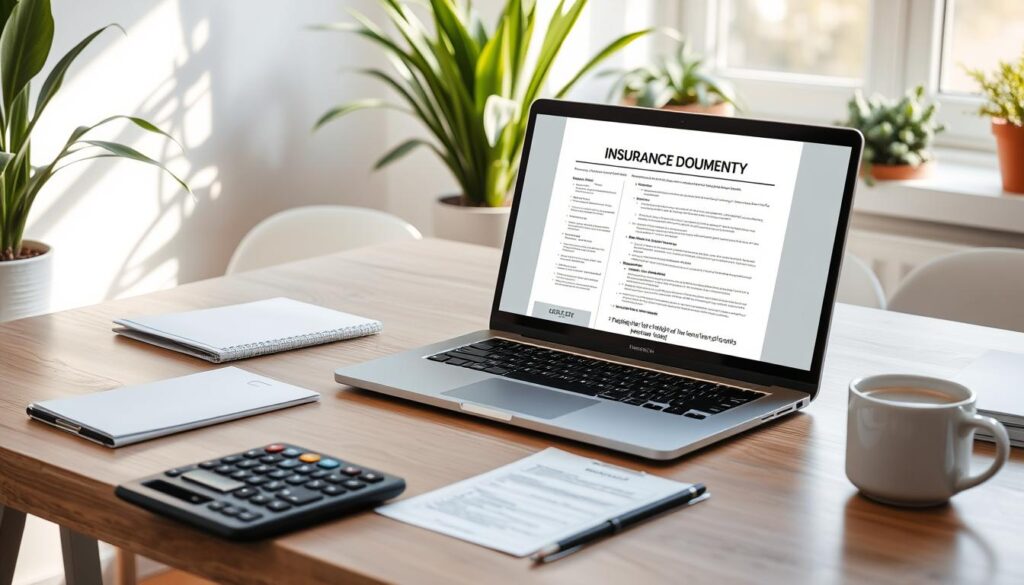Having a financial safety net is key to avoiding debt and keeping your finances stable. You can achieve this with insurance or an emergency fund. Both options give you peace of mind and protect you from unexpected costs.
With living costs going up, it’s vital to have a plan. Try to save enough cash for at least six months of living expenses. This is a crucial part of your emergency savings.
An emergency fund acts as a safety cushion for sudden income drops or big, unplanned bills. It ensures your financial security. Insurance, on the other hand, protects you from specific risks, making it a must in your financial planning.
About 40% of Americans can’t cover a $400 emergency expense. This shows how important an emergency fund is for financial security.
To build an emergency fund, you need discipline and patience. Start by saving 10-15% of your monthly income. Automate your savings to keep it going. Use windfalls like tax refunds or bonuses to boost your emergency savings.
Regularly check how your emergency savings are doing. Make changes every three to six months. By focusing on emergency savings and insurance, you create a strong financial safety net. This gives you the security you need to face life’s surprises.
Understanding Insurance and Emergency Funds: Key Differences
Securing your financial future involves two key tools: insurance and emergency savings. Insurance covers specific risks like health issues or accidents. Emergency savings, on the other hand, help with unexpected costs, preventing debt and stress.
An emergency fund is vital for long-term planning. It should cover three to six months of living costs. This way, you’re ready for any unexpected event. Insurance, by contrast, protects you from specific risks like health problems or accidents.
Some main differences between insurance and emergency funds are:
- Purpose: Insurance guards against specific risks, while emergency savings handle unexpected costs.
- Structure: Insurance comes with monthly payments, while emergency savings go into a savings account.
- Benefits: Insurance protects your finances in specific situations, while emergency savings offer quick, flexible access to money.
Knowing the differences helps you plan better for your financial future. You’ll have the right tools to protect your money.
| Financial Tool | Purpose | Benefits |
|---|---|---|
| Insurance Policy | Provides protection against specific risks | Offers financial protection in case of specific events |
| Emergency Savings | Serves as a cushion for unexpected expenses | Provides flexibility and quick access to funds |
The Power of Insurance vs. Emergency Fund in Financial Planning
Securing your financial future involves two key tools: insurance and emergency funds. A good plan offers financial security and peace of mind. It’s important to decide whether to focus on insurance or an emergency fund.
Insurance acts as a safety net against unexpected events like medical emergencies or natural disasters. An emergency fund, on the other hand, helps cover unexpected expenses without debt. Financial security is the main goal, and both insurance and emergency funds are vital.
To prepare for emergencies, follow these steps:
- Set clear savings goals, such as saving 3-6 months’ worth of expenses
- Choose a liquid account, like a savings or money market account, for easy access to funds
- Automate savings transfers to make building your emergency fund easier
Understanding the role of insurance and emergency funds in financial planning is crucial. A solid plan helps you face life’s surprises with confidence.
| Expense Category | Monthly Expense | 3-Month Emergency Fund | 6-Month Emergency Fund |
|---|---|---|---|
| Single Person | $4,300 | $12,900 | $25,800 |
| Family of Four | $9,200 | $27,600 | $55,200 |
When Insurance Makes More Sense for Protection
Insurance coverage is key for financial safety in big emergency costs. It’s a big part of planning for the future. It helps protect against unexpected events like medical crises or natural disasters.
Insurance can be better than just an emergency fund in some cases. For example, long-term care considerations need a strong insurance policy. Insurance also offers peace of mind and financial security.
High-Cost Emergency Scenarios
Big emergencies like medical issues or car accidents can be very costly. Without insurance, they can ruin your finances. But, insurance can help pay for these costs and ease your financial worries.

Long-term Care Considerations
Long-term care, like nursing home or home health care, is very expensive. Insurance for these costs can help. It ensures you get the care you need without losing all your money.
Adding insurance to your long-term plans makes your financial safety net stronger. You can mix different policies, like life, health, and disability insurance. This way, you’re protected against many risks and uncertainties.
Building and Maintaining Your Emergency Savings
Having a solid emergency fund is key for financial security and emergency preparedness. A 2024 Bankrate survey found that 44% of Americans can handle a $1,000 emergency with their savings. Yet, 63% say rising inflation is making them save less for emergencies.
To grow and keep your emergency savings, set aside a part of your income each month. Start with small amounts and use automatic transfers to build your fund. Experts suggest your emergency fund should last three to six months.
Some important stats to remember:
- 53% of Americans can’t cover a $500 emergency with their savings.
- Those with less savings are 3 times more likely to face financial struggles after a shock.
- Households with an emergency fund save about 15% more than those without.
By focusing on your emergency savings, you can ensure financial security and be ready for unexpected costs. Even a small emergency fund can cut the chance of using high-interest debt by 30%.

Conclusion: Creating Your Financial Safety Net
Getting to long-term financial security needs a mix of insurance and emergency funds. Insurance helps with big, unexpected costs. An emergency fund is key for daily money surprises. Together, they make a strong financial safety net for your future.
Experts say save at least $2,000 for quick spending shocks. Then, add 3-6 months’ living costs for income shocks. Keep this emergency savings in cash or easy-to-use forms. This way, you’re ready for sudden costs without debt.
Adding a good insurance plan helps avoid huge financial hits. This includes long medical care or long-term care needs.
Focus on both insurance and emergency fund plans. This will help you build a strong financial safety net. It gives you peace of mind and secures your financial future. Being smart with your money is the way to true financial security.

